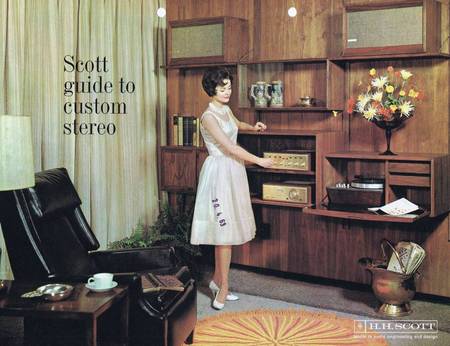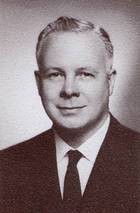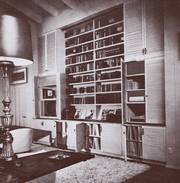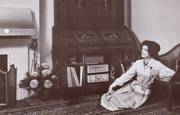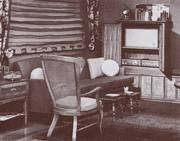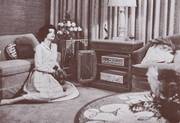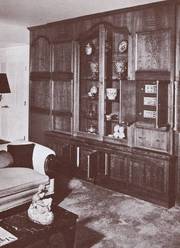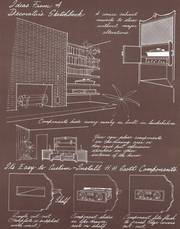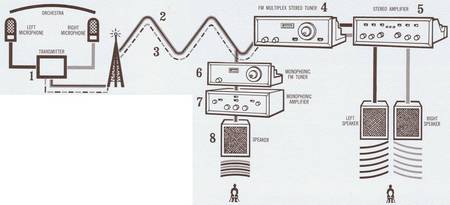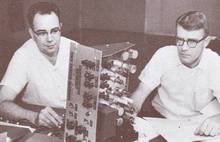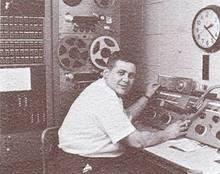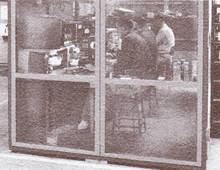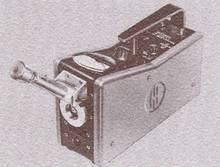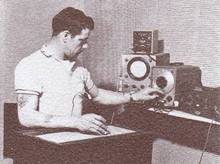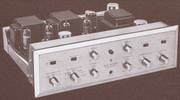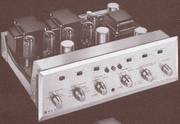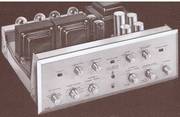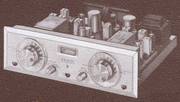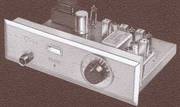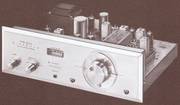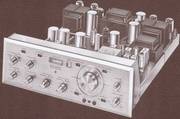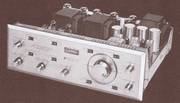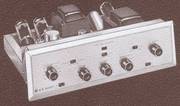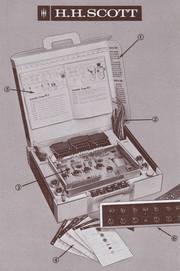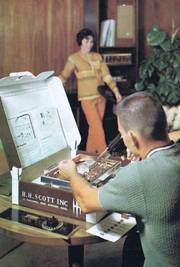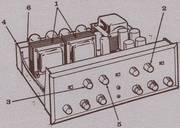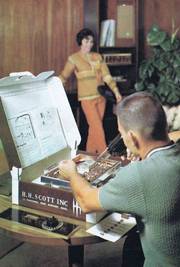In den Jahren 1960 bis 1965/68 war es in den USA üblich ...
... in die Produkt-Kataloge die Lern-Fibel für HighFidelity - später auch für STEREO - mit einzubringen und die (eigene) Firma in den tollsten Farben zu "beleuchten". So auch hier. Es beginnt also mit der Lobeshymne auf den Urvater der Firma SCOTT und endet wiederum mit einem ganzen "Haufen" Eigenlob.
Weiterhin fällt es hier noch nicht so auf, aber bei späteren Prospekten und Katalogen ist es eklatant. Bei jedem Hersteller in den USA waren die eigenen Produkte "alle" outstandig = "herausragend" und jedes Gerät hatte seine outstanding performance.
Auch fällt auf, daß man in den frühen Zeiten das Wort "Receiver" für Tuner/Verstärker noch nicht benutzte, das von den Deutschen erfundene "Preceiver" für Empfänger/Vorverstärker schon gar nicht. Weiterhin fällt auf, daß hier keine Preise stehen. Das Prospekt war vermutlich für den internationalen Markt vorgesehen und auch in Deutschland verteilt worden.
Hermon Hosmer Scott . . . Audio Pioneer
"Hermon Hosmer Scott is a soft-spoken man, with a down-East accent to which he is entitled. We have been gratefully aware of him since 1947. He is the man who took the grit out of Grieg and the scratch out of Scriabin by inventing the Dynaural Noise Suppressor. If you use an H.H.S./D.N.S. a 78 sounds as clean as an LP, and an LP sounds as clean as live FM.
"Scott has received many engineering citations, some for truly basic work in electronic measurement ... yet he is honored and heeded most by his friends on the grounds of ethics and esthetics. This ... is reflected in the clear reliability of his products.
"Scott ... is terribly irritated by imperfections of any kind. He does not see why an amplifier or a tone arm should be ugly any more than a 'cello is. To this we owe a revolution since it was Scott who in 1953 gave us the Model 99 amplifier which did not need to be hidden . . . Everyone now follows this precedent, but it was Scott who established it, and the Scott musical gear still looks best of any."
- John M. Conly, Atlantic Monthly (1963)
An introduction to Stereo
H.H. Scott, the world's foremost manufacturer of fine high fidelity components, brings your family a new, better way to enjoy beautiful stereo music in your home. This is the way record reviewers, professional musicians and critical music lovers have chosen for greatest realism. This new way utilizes separate components ... an amplifier, a tuner, a record player and speakers ... which combine to make up a music system of unsurpassed quality.
H. H. Scott components are easy to choose ... fun to use. They are the product of painstaking research and development ... creative engineering ... skillful, patient manufacturing. Each Scott component receives more than 50 separate tests before it is awarded the Laboratory Standard Guarantee. This care in design and manufacture means th^ your H. H. Scott system will perform perfectly through many years of continued use.
We know you will be as proud to own Scott Stereomaster Components as H. H. Scott is to make them. In this new guide we show Scott components and describe their function and appearance. We explain stereo, high fidelity, and new FM stereo (multiplex), and show you what to look for when choosing your system. We tell how to use components and illustrate easy ways to place them in your home. All pertinent technical information is included and explained to help you select the proper system to suit your needs and your budget.
WHAT IS HIGH FIDELITY SOUND?
High fidelity sound re-creates in your own living room the true beauty and depth of the original concert hall performance.
There are two systems of high fidelity, "monophonic" and "stereophonic." A monophonic recording is entirely on a single channel. The output from one microphone (or the mixed outputs from a group of microphones) form this channel. With a stereophonic recording, a double system is used, resulting in greater realism. In its simplest form, two groups of microphones are placed at different sides of the orchestra to provide material for the two recording channels. To play the recording back, a two-channel system is required. At least two separate speakers are used, one to the right and one to the left. Stereophonic sound is much like 3-D photography. The two different sound sources re-create a dimensional pattern, similar to that formed by the original orchestra or other program source. You can hear stereo three ways: either from records, tape, or from new FM stereo broadcasts. This new form of broadcasting is explained in detail later in this booklet.
NOT ALL PHONOGRAPHS ARE HIGH FIDELITY!
The words "hi-fi" and "stereo" are often loosely used by manufacturers of "console" radio-phonographs. In actuality, high fidelity refers only to quality of sound. "Monophonic high fidelity" means fine quality single-channel sound. "Stereo high fidelity" means fine quality multi-channel sound.
Laboratory tests and actual listening indicate that the quality of sound from most console systems is far from ideal. Usually, to meet the needs and desires of the "mass market", compromises and sacrifices have been made in loudspeakers and electronics, resulting in inferior sound.
Leading independent consumer testing organizations have long maintained that the best sound reproduction comes from a sound system made up of individual components selected by the customer, rather than from a console radio-phono system.
WHY IS COMPONENT HIGH FIDELITY BETTER?
With components the value is concentrated in the electronic equipment, rather than in the cabinet. When you buy components you pick the particular parts you want to fill your needs and plug them together to form a complete system. With components you can separate the loudspeakers from the record playing equipment so that speaker sound vibration will not interfere with the perfect reproduction of the recording. You can place the speakers far enough apart for perfect stereo, and put the components where they look best jcoratively. The small specialized companies who manufacture fine components can maintain far higher standards of quality and performance and true dedication to their product than is possible in the mass-produced consoles.
WHAT ARE THE DIFFERENT COMPONENTS IN A HIGH FIDELITY SYSTEM?
The Tuner captures the radio waves from the air. There are two kinds of radio transmission: AM and FM. Most ordinary table radios receive AM only. FM is a newer form of static-free radio broadcasting being used to transmit many good music programs. FM stations can broadcast either stereo or monophonic programs. You can buy either an FM tuner, an FM stereo tuner, or an AM-FM tuner depending on your needs.
The Turntable is a precision piece of equipment, made as carefully as a fine watch. Associated with the turntable is the arm and pick-up cartridge. The cartridge holds the diamond phonograph stylus and transforms the movement of the stylus in the record groove to electrical signals. Record changers are sometimes used instead of turntables, although in a true high fidelity system the turntable is preferred.
The Amplifier is the link between the tuner or turntable and the speakers. The amplifier strengthens the minute signals fed into it by the tuner, tape recorder or record player and turns these signals into electrical impulses strong enough to drive the speakers. It is with the amplifier that you control the sound ... make it louder or softer ... or change the tonal balance to suit your ears.
The Speaker. It is here that the carefully controlled electrical signal is changed into sound waves you can hear. The speaker and its enclosure are ideally purchased as an integral unit. The enclosure is as important to the speaker as the sounding board is to the strings of a piano.
CUSTOM STEREO IN YOUR HOME WITH H. H. SCOTT COMPONENTS
Component stereo is actually "Custom Stereo." Because components are separate units, you can choose the parts you want and need to fit your budget and your room. These compact electronic units fit anywhere, even in rooms where you might think that installation of a fine stereo system is improbable.
Attractive slip-on cases are designed to fit all H. H. Scott components, which are so handsome in themselves they can be placed anywhere right in these cases.
H. H. Scott components can be placed in furniture you already own, on tables or in bookshelves. They can be used in cabinets designed especially for components, in standard furniture simply adapted to components, or custom-installed in walls, doors or panelling.
1. IN FURNITURE YOU ALREADY OWN ...
You can arrange components easily in popular antique furniture like a dry sink, buffet, or chest. An H. H. Scott component takes only about one square foot of space. For-contemporary homes where living and dining rooms are in the same area, components can be tucked into a buffet or hutch cabinet. The equipment can be concealed with tambour, hinged, caned, louvered or reversible doors. Equipment can be neatly displayed on a shelf that usually houses china. You can put components on a bookshelf, along with art objects, and shift them later to a cabinet to suit your changing tastes.
An H. H. Scott system gives you exceptional flexibility. The equipment can be decoratively assembled on a corner table, a window shelf, in a desk compartment, or housed in its own handsome cabinet. Many apartments have built-in wall closets which are ideal for music systems. Simply set the components on the shelves. If the closet doors have a wire grille, upholstery or curtain fabric can be placed behind the grille, concealing the components and giving the room decorative unity.
2. IN SPECIAL CABINETS DESIGNED FOR STEREO COMPONENTS ...
There is a wide selection of furniture, made specifically fo. stereo components, available from the same dealer who supplies you with the components themselves. These cabinets come in a variety of sizes and finishes, usually with space for a record player, amplifier, and a tape recorder. Record storage space is provided in many of the cabinets, or in matching cabinets that hold hundreds of stereo records. Installation is a matter of minutes, and you have a handsome unit blending perfectly with the feeling and decor of your rooms.
3. IN STANDARD FURNITURE ADAPTED TO STEREO ...
Most fine furniture stores have available cabinets readily adaptable to H. H. Scott stereo components. Since the components measure only about 15" wide by 13* deep, a small shelf will hold them.
Decorators frequently use H. H. Scott components in buffets, hutch cabinets, storage units of all types, or in small end tables. Components hide away in any piece of furniture with doors. The only adaptation required in most cases is the
drilling of small holes in the back of the furniture for ventilation. This does not alter the appearance of the furniture. Most furniture stores can do this for you in a few minutes.
The advantage of components in this case is obvious. You don't ever have to settle for a bulky mass-produced console when you use Scott components which are so compact you can slip them into any piece of furniture you desire.
4. IN CUSTOM BUILT-IN INSTALLATIONS ...
The growth of the high fidelity industry has brought with it specialists in the decorating field who are also trained in audio installations. More and more people are consulting decorators to design and construct music systems in their homes. In most cases these systems are built into the wall and concealed by wood panelling. Special units can be designed to house any combination of equipment (high fidelity system with speakers, record storage, tape recorder, etc.). Only one simple cut-out is required to panel mount an H. H. Scott component.
H. H. SCOTT STEREO ... EASY TO BUY AND USE
Purchasing Scott Stereo Components is easy. There are more than 500 franchised H. H. Scott dealer showrooms across America. Audio specialists at these showrooms will be glad to demonstrate Scott components for you, and help you select those best suiting your needs.
Installation is simple. You can do it yourself, or your H. H. Scott dealer will install your system for you at modest cost.
Scott components are easy to use. The panels are marked with small dots showing typical knob settings, so any member of your family can play your system. Many Scott components come with a convenient "Photo-Guide." Even without these special helps, you can learn to use H. H. Scott components in a short time.
Most controls are set once to conform to the acoustics of your room. You use only the volume control, the off-on switch and the selector switch with any regularity.
As you will see on the next few pages H. H. Scott makes a variety of components in many different price ranges so that you can select those that best suit your needs and your budget. Your Scott stereo system need not be expensive. You can purchase a component system for as little as $30 down at most dealers and arrange convenient budget terms.
There is no need to compromise in selecting your stereo system. You can have the best for your family at moderate cost. Your stereo system will look attractive and be designed for your needs. Visit your nearby H. H. Scott showroom now for a demonstration.
How FM Stereo (Multiplex) Works
Multiplexing is a method of broadcasting two or more signals from one FM transmitter. This means that a single FM station can broadcast both the left and right channels of a stereophonic program from records, tapes, or live performances.
WHAT IS NEEDED TO ENJOY FM STEREO?
The listener needs only an FM tuner equipped for multiplex (like the Scott 350) or an FM tuner together with a multiplex adaptor, plus the usual accoutrements of stereo (a dual channel amplifier and two speakers). Operation is not complex. You just tune to one station as you do now for regular FM broadcasts, and you hear true stereophonic sound with all the advantages of FM - freedom from noise, interference and distortion.
HOW MULTIPLEX STEREO WORKS
Humans are capable of hearing sounds between about 20 and 20,000 cycles per second. Any sound above 20,000 cycles per second is referred to as "supersonic" because it is above the range of human hearing.
Most good FM tuners are capable of reproducing these supersonic frequencies above 20,000 cycles per second ("cps" for short). Though you cannot hear them, these supersonic frequencies are used very effectively for multiplex. At a frequency of 38,000 cycles per seeond (cps), high above the sounds you can hear, the second (stereo information) signal is added on. While you can't hear this second signal, your FM tuner can, and, if equipped for multiplex, will convert this into sound you can hear - stereo sound.
This second signal is not either the left or right channel. If it were, a listener with a monophonic tuner would hear only half of the program. Instead (see diagram below), a method is used that provides the full monophonic signal (left plus right) for the listener with a regular FM tuner, and stereo for the listener with multiplex equipment.
The stereo quality depends on how well the multiplex tuner handles the second signal (stereo information). If very little of the second signal is being properly processed, there will be poor stereo quality (poor separation between the left and right channels). Simply having sound from both speakers does not necessarily mean you have stereo.
Conventional narrow-band tuners cannot give the fine stereo quality obtained with Scott Wide-Band tuners. As the FCC pointed out, the approved multiplex stereo system "... like any multiplex transmission system, will increase energy transmission at the edges of the channel involved. Accordingly for optimum stereophonic reception, the (tuners) bandwidth ... must be considerably greater than that of monophonic (tuners)...."* Scott tuners have always had the wider IF bandwidth needed. Therefore, if you now own a Scott tuner, adding a 335 or LM-35 adaptor to your system will give you outstanding stereo separation matching the FCC transmission specifications.
.
Since stereo FM broadcasts are such an abundant source of high quality program material, many listeners will want to make off-the-air stereo tape recordings. In many instances, however, conventional multiplex circuitry causes interference with a tape recorder, resulting in whistles and beeps being recorded on the tape. Scott multiplex units incorporate the expensive filters needed to prevent this interference. Scott equipment can be used with any tape recorder.
New FM Stereo will bring you thrilling broadcasts of world famous symphony orchestras and opera companies ... intimate close-ups of jazz in stereo ... dramatic presentations with life-like movement. You will hear the wonderful new sound of FM multiplex stereo in your home ... and using Scott equipment, you will be able to make flawless off-the-air stereo tape recordings.
*Seeparagraph 36, FCC Report and Order, Docket No. 13506, 4/19/61.
Here is How H.H. Scott protects your investment
The modern refrigerator is a giant-step above the ice box in what it accomplishes . . . and in its complex design. Similarly, component high fidelity reaches far beyond regular radio in performance and complexity. Today, whether we are purchasing a refrigerator or stereo components, most of us do not have enough technical knowledge to gauge the quality of the engineering. Therefore, we must rely on the opinions of others in making our decision. We must examine the background and reputation of the company. We must listen to the comments of other owners. Let's examine H. H. Scott in light of this:
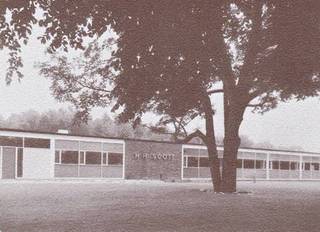
- To insure that every component meets the highest standards of quality, H. H. Scott maintains ultra modern production facilities for the design and manufacture of all its components. The main plant shown above, is one of three Scott plants located in Maynard, Massachusetts. These extensive investments in facilities back up H. H. Scott's philosophy that there will never be any compromise with quality.
- 1. Scott engineers are imaginative. They analyze problems in fresh ways, solve them through sound engineering techniques. Until Scott, in 1952, solved the engineering problems involved in designing a "flat" amplifier covered with a handsomely styled case, high fidelity components were consigned to the workshop. They were ugly and bulky ... a maze of tubes and wires. This Scott styling innovation was immediately adopted throughout the industry.
- 2. Scott protects you against obsolescence. When Scott designed its first tuner in 1954, their engineers developed a new kind of circuitry using Wide-Band design. This circuitry provides drift-free operation, low distortion, wide frequency response, and exceptional sensitivity. Today, with FM stereo multiplex a reality, Wide-Band design is essential. With other manufacturers compelled to use Wide-Band circuitry for satisfactory FM stereo performance, Scott's pioneering Wide-Band tuner design of eight years ago has become the latest example of Scott's engineering leadership.
- 3. Scott is highly conservative in use of parts. Scott engineers always specify parts that can handle much more than demanded of them. For example, Scott rates the LK-150 amplifier at 65 watts per channel. The output tubes are rated by their manufacturer at 100 watts.
- 4. Scott is equally conservative in its advertising claims. Scott was the first manufacturer to use the Institute of High Fidelity Manufacturers (IHFM) test procedures. These stringent test methods often made our specifications compare unfavorably to meaningless figures used by many others ... but Scott felt it was essential to establish meaningful industry standards and led the way. Even now many manufacturers do not use IHFM measurement techniques in rating their products.
Scott's IHFM ratings are consistently conservative ... Scott insists that every unit off dealers' shelves should exceed advertised specifications ... these figures should not apply to just a selected engineering master sample. As a result, engineering tests by leading high fidelity publications consistently shows rating better than claimednby Scott. - 5. Every Scott component receives more than 50 separate quality tests before it leaves the factory. Our test engineers insist on these rigid test procedures to assure long trouble-free operating life.
- 6. H.H. Scott components are in use throughout the country by leading musicians, engineers, radio stations, and the editors of most leading high fidelity magazines. Scott quality has been proved by nearly a generation of music lovers.
- 7. Scott feels that its service to the customer begins with his purchase. We feel that your problems are our problems, and we have many fine letters from satisfied Scott owners well pleased with our service. The best salesmen for Scott components are these happy owners (including leading musicians, electronic authorities, etc.). Scott has grown over the years because enthusiastic owners recommend Scott to their friends and acquaintances. Before you decide on your high fidelity system, we suggest that you ask the man who owns Scott.
.
222C 48-Watt Stereo Amplifier (tubes):
This moderately priced amplifier uses heavy duty output transformers for superb bass response even with inefficient speaker systems. The many special features include derived center channel output, separate tone controls on each channel, DC on preamp heaters, subsonic filter, front panel stereo headphone output, and scratch filter to improve the performance of old records. Only the finest conservatively rated parts are used. The all-aluminum chassis construction assures efficient cooling and reduces hum to inaudible levels. The 222C is a perfect match to all H. H. Scott tuners.
299C Complete Stereo Amplifier:
The most widely used, highly respected stereo amplifier made... the latest version of the amplifier recommended by both leading consumer testing organizations. Features include: rugged 72-watt output stage assuring low-distortion reproduction of even the lowest frequencies; special signal lights make it easy for any member of your family to operate your system; stereo selector switch for choosing stereo or monophonic program sources; separate scratch and rumble filters; Front panel stereo headphone output; and derived/center channel level control.
296 100-Watt Complete Stereo Amplifier:
Here is a compact integrated amplifier with the high power rating and flexibility previously found only in separate preamp/power amplifier systems. In addition to all the features of the 299C, the 296 has the patented Dynaural Rumble Suppressor, which removes annoying turntable or record rumble during playback without loss of audible music. Each output stage delivers a. full 50watts from 20 to 20,000 cps, more than enough power for any speaker system. Variable phono level control permits precise matching to any phono cartridge or tape deck.
4310 FM Stereo Multiplex Broadcast Monitor:
This is our finest.... without doubt the most sensitive, reliable FM tuner ever made. This new tuner is packed with so many unique features it would take several pages to describe it properly. It has 3 Separate meters, automatic switching circuitry, unmatched separation. There is actually a built-in computer assuring perfect reception under hitherto impossible conditions. A complete specification sheet is available on,request.
333 AM/FM/Stereo Multiplex Tuner:
This superb tuner incorporates all the features of the widely respected 350BFM Multiplex tuner, along with Scott's unique Sonic Monitor. In addition, the 333 includes Scott's famous Wide-Range AM with two position bandwidth switch which makes AM listening practically indistinguishable from FM. The 333 allows you to listen to either AM/FM stereo or new FM Multiplex stereo.
314 Wide-Band FM Tuner:
The 314 is ideal if you wish outstanding monophonic FM reception at a moderate price. You can adapt for FM Stereo whenever you wish with the 335 adaptor. IHFM sensitivity is 12.5uV. Silver-plated front end is the same as in the 310D. Like all Scott tuners, the 314 has a copper-bonded-to-aluminum chassis which minimizes signal losses and maintains outstanding signal to noise ratio.
350B Wide-Band FM Stereo Multiplex Tuner:
Built-in multiplex circuitry lets you receive new FM stereo broadcasts without an adaptor. The 350B also receives regular monophonic FM broadcasts. Scott's new Sonic Monitor tells you automatically when stereo is on the air. Simply turn the switch and tune to the tone. Scott's Wide-Band design assures IHFM sensitivity of 2.2uv and stereo separation that matches exacting FCC transmission specifications. Exclusive Scott filtering circuits permit flawless results with any tape recorder.
355 AM/FM Stereo Multiplex Tuner/Preamplifier
with 208 80-Watt Stereo Power Amplifier:
The new 355 tuner/preamplifier includes both famous Scott Wide-Range AM and widely acclaimed Scott multiplex FM circuitry, the standard of the high fidelity industry. A separate power amplifier module (Model 208) can be attached directly to the 355. If desired, the 208 can be separated by as much as fifty feet from the 355.
When you purchase the 355 and 208 in combination you have the performance of four distinct components: FM Multiplex Stereo tuner, Wide-Range AM tuner, stereo preamplifier, and 80-watt stereo power amplifier.
340 60-Watt FM Stereo Multiplex Tuner/Amplifier:
A sensitive Wide-Band FM Multiplex tuner, a complete stereo control center and 60 watt power stage all on one compact chassis. Unique Sonic-Monitor tunes to the tone to tell you audibly when FM stereo programs are on the air. If you do not require AM, the 340 provides all the outstanding performance of the 350 and an amplifier providing full power down to 20 cps. The 340 offers superb performance and amazing flexibility at modest cost.
99D 22-Watt Monophonic Amplifier:
Tens of thousands of 99D amplifiers are in use in monophonic systems all across America. If you do not desire a stereo system, this amplifier is your best buy. The 99D incorporates exclusive H.H. Scott features like two magnetic inputs, tape recording and monitoring facilities, front panel speaker selector switch, all-aluminum chassis, and DC heaters on all preamps tubes.
335 Wide-Band FM Stereo Multiplex Adaptor:
The 335 converts any H. H. Scott tuner, regardless of age or model, to FM Stereo (multiplex). The combination of the 335 and your H.H. Scott tuner offers the same flexibility and tape recording features as the 350B FM Stereo Tuner. Because the 335 was designed specifically to match Scott's Wide-Band tuner design, optimum stereo performance is guaranteed only when a Scott tuner and the 335 are used together.
1000 Matched Stereo Arm and Cartridge:
The London-Scott model 1000 stereo arm and cartridge is, to quote the Saturday Review, "still without a serious rival." To quote The Gramophone, it is "the ne plus ultra of stereo cartridges." This matched, integrated arm and cartridge brings you stereo at its very best. The tracking ability of this unit is truly phenomenal. There is an interchangeable head for 78rpm recordings that makes them sound almost new.
Scott Speakers Complete Your Stereo System
All H. H. Scott speaker systems, regardless of price, incorporate the following features:
.
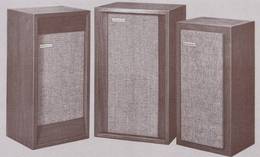
- Shown are the three exceptional Scott speaker systems. The Model S-2 (center) is, we believe, the finest speaker system available. Its smooth, full response is unsurpassed. The S-3 (left) is of true bookshelf size, measuring only 9/4 inches deep. Its ability to reproduce the low end of the sound spectrum is surpassed only by the S-2. Newest Scott speaker is the modestly priced SK-4 (right) kit. At below $100 this three-way speaker system possesses a smoothness possible only through use of Scotfs unique crossover circuitry.
- Three-way design to insure that each driver operates over its optimum frequency range. This design utilizes separate woofer, mid-range and tweeter units.
- Passive multiple crossover circuitry - Extended frequency response afforded by the three-way design is coupled with remarkable smoothness of response.
- Controlled efficiency - The uniformity of the efficiency of each system eliminates peaks and valleys in response.
- High dispersion - Speaker placement is not critical. The full frequency range of the systems can be enjoyed regardless of their location.
- Handsome appearance - These systems are handsome pieces of furniture which will add to the attractiveness of your room decor.
.
Experts Top-Rate Scott Speakers :
"... The S-3 has an exceptionally clean, balanced and transparent sound ... Compares favorably to other systems costing two to three times as much ... We liked its true musical sound immediately on hearing it for the first time, and it continued to please us with continued use ..."
Hirsch-Houck Report in Electronics Worlds March, 1962
"... reproduces music with as little coloration as any bookshelf speaker system we have heard. Both extremes of the audible frequency spectrum are solid while the mid-range has just that touch of brightness that we personally enjoy ..."
Audio, March, 1962
"... a clean speaker and a very smooth one ... There is no boom or bass hangover here. Every sound is heard ..."
American Record Guide, February, 1962
.
S-2 Wide Range Speaker System
This superb speaker system employs four precision drivers and the famous Scott three-way crossover network to provide smooth, distortion-free reproduction over the entire audio spectrum. A massive 12" low resonance, high excursion woofer provides fundamental response to below 30 cycles. Two carefully matched mid-range units are angled for outstanding dispersion and acoustically isolated to prevent intermodulation. A remarkable high dispersion spherical tweeter affords response to the upper limit of audibility regardless of location in the room. 23"x14"x12" deep. Available in oil finished walnut, mahogany, and unfinished pine or hardwood.
S-3 Wide-Range Speaker System
This 3-way speaker system offers remarkably natural and transparent sound. Only 9%" deep, it is of true bookshelf size. The S-3 consists of a 10" low resonance high excursion woofer, and separate wide-dispersion mid-range and tweeter units, ail contained within a strikingly handsome cabinet. The three-way crossover network blends the separate speakers into a single sound source of astonishing range and clarity. Testing techniques pioneered by H. H. Scott assure virtually ideal matching from speaker to speaker for exact stereo balance. Dimensions 23" x 11" x 9" deep. Available in oil finished walnut, mahogany and unfinished pine or hardwood.
NEW SCOTT SPEAKER KIT!
SK-4 Wide-Range Speaker Kit:
Brand new! An easy to assemble three-way acoustic compliance speaker system that includes many of the features of the highly-rated S-3. Handsome factory assembled, professionally pre-finished cabinet assures you of superb looks as well as superior sound. Available in mahogany or oiled walnut, unfinished hardwood and unfinished pine. 22"H x11"W x9"D.
Revolutionary New Scottkits for the do-it- yourself fan :
"exemplifies engineering of the highest calibre ... the simplest to build we have seen to date."
- Audio Magazine
Here are kits that make you a professional. Beautifully designed, perfectly engineered, and so easy to wire you'll find it hard to go wrong. These kits have been acclaimed by the experts, and enthusiastically received by thousands of delighted kit builders.
Scott engineers have developed exciting new techniques to simplify kit building. With a few hours of interesting work, you can build any one of seven superb amplifiers and tuners with complete confidence that your completed kit will have the professional performance and handsome appearance long associated with Scott products.
Read What Leading Magazines Say About New Scottkits!
"These Scott units are more beginner-proof than any other kit on the market. ... The amplifier sounds as it tests, quiet and clean ... . The completed kit is capable of performance as good as many units costing far more. Highly recommended."
American Record Guide
High Fidelity tested the LT-10 and reported on it in their April 1961 issue. They found it the most sensitive tuner ever tested by IHFM standards. In their equipment review they stated that the LT-10 "... sounds as good as it measures, and that is the highest compliment one can pay."
High Fidelity Magazine
"... No effort has been spared to make the building job simple, a lot of fun, and yet have the builder end up with a unit that looks and works like factory-built equipment . . . Whizzed through the complete construction (of the LK-72) in only about 11 1/2 hours. A conservatively designed, versatile integrated stereo amplifier that should be a pleasure to build
and a pleasure to use."
Electronics World
"... It took us less than 7 hours to put (the LT-10) together and that includes alignment. ... Without hesitation we would recommend the H. H. Scott LT-10 FM Tuner Kit to the beginner as well as the more experienced Audiofan. ... Surely only the most sophisticated engineering thinking could design a kit as simple and foolproof as this one is. "
Audio Magazine
Electronics Illustrated in a project designed to construct and test every FM tuner kit available reported the LT-10 was "the most sensitive ... tuner" tested.
7 Reasons Why Scottkits are Fun to Build:
- 1. Kit-Pak Container opens to a work table. Packs up at night so it can be stored out ot sight and out of the way.
- 2. All wires pre-cut, pre-stripped, pre-tinned and color-coded. Saves hours of work. Assures perfect lead length, best performance.
- 3. All mechanical parts such as terminal strips are pre-riveted to the chassis at the factory. Saves time, improves performance.
- 4. All parts come mounted on special Part-Charts in the order in which you will use them. This simplifies construction, eliminates chance of error.
- 5. Instruction book is printed in full color so you can visually identify parts quickly and without error.
- 6. Results are completely professional both in appearance and performance.
- 7. Tuner kits use special H. H. Scott Ez-A-Line alignment system utilizing the meter on the tuner itself. All special tools needed are-sup-plied. Complete alignment takes less than 15 minutes. Amplifier kits require no external equipment for adjustment.
.
Build These Handsome, Professional Scottkits
.
LT-110 FM Stereo (multiplex) Tuner:
Now you can have the fun of building your own Scott FM stereo tuner. The new LT-110 utilizes the same superb front end used in the famous Scott 310D Broadcast Monitor Tuner. The front end and multiplex sections are prewired and pre-aligned at the factory assuring ideal reception and stereo quality even in weak signal areas, and eliminating the need for elaborate test equipment in alignment. The silver-plated front end, copper-bonded-to-aluminum chassis and Wide-Band design all contribute to exceptional IHFM sensitivity of 2.2 microvolts. The LT-110 uses an even more simplified Ez-A-Line method than that used so successfully by builders of thousands of LT-10 tuners.
LK-72 80-watt Complete Amplifier:
You would have to spend at least half again as much for separate pre-amp/power-amp kits to approach the performance and features of the LK-72. Thousands of kit-builders have had the fun of assembling this superb H. H. Scott amplifier. Even novices have been able to achieve outstanding results due to Scott's revolutionary kit building techniques. Typical assembly time is approximately 15 to 20 hours. Front panel derived center channel level control, switching facilities that enable simultaneous connection of both a stereo tape deck and stereo cartridge, and a full 40-watt/chan-nel (IHFM) over the entire audio range make this amplifier kit the most outstanding value on the market today. Compact and handsome looking, it is professional in all respects.
LK-48 48-watt Stereo Amplifier:
Conservatively rated at 24-watts (IHFM) per channel the LK-48 will deliver more than 28 watts (IHFM) at 20 cpsl This exceptional power at the low frequencies means that your LK-48 can be used with any speaker systems. This unit offers the features, fine performance and smart styling of Scott's wired units at a substantial saving to you. Though budget priced, it offers no compromises in design: all aluminum chassis, DC operated pre-amp heaters, subsonic filter, and complete tape monitor switching facilities are a few of the features offered. You will be proud to build this fine Scottkit.
.
- 1. Mechanically assembled chassis saves you hours of tedious work.
- 2, Massive output transformers assure full power response down to 20 cps.
- 3. Hum-null balancing for virtually unmeasurable distortion.
- 4. Derived center channel output.
- 5. Tape recorder and monitor provisions.
.
LC-21 Stereo Control Center:
This exceptional preamplifier kit has every feature you'll ever need or want. It is so perfectly designed that distortion is below the limits of even the finest test equipment, and cannot be accurately measured. Hum is completely inaudible even in the magnetic positions due to the all-aluminum chassis, shielded power supply, and DC heated tubes. The LC-21 can be used for laboratory applications where frequency response below 10 cps is desired. Among the 16 front panel controls are complete tape monitor switching facilities, front panel derived center channel level control, and phase reverse switch. The LC-21 is an ideal companion to the LK-150 stereo power amplifier kit.
LK-150 Stereo Power Amplifier:
The IHFM power band of this 130 (65/65) watt unit goes beyond the 19 to 25,000 cps range of available test equipment. Conservatively engineered, the highly efficient design of the LK-150's powerful output transformers will typically provide 80 watts (IHFM) output on each channel at 20 cps - where the power is really needed. Famed matched 6550 output tubes - rated at 100 watts - are used well below manufacturer's ratings to assure long operating life. Switchable subsonic filter permits the use of the LK-150 for laboratory applications where response below 5 cps is required. Input sensitivity is switchable between 2.5 volts (for the LC-21 and other Scott preamplifiers) and 1.5 volts for preamplifiers with lower output.
LT-10 Wide-Band FM Tuner:
The LT-10, introduced just one year ago, has single-handedly changed the hitherto common impression that it was impossible to build a good FM tuner kit. High Fidelity Magazine buiit and tested an LT-10. They found it the most sensitive tuner ever checked for IHFM sensitivity, either kit or wired, regardless of price. Nominally rated at 2.2 microvolts iHFM sensitivity, LT-10s typically provide even more sensitive performance (High Fidelity found 1.4uv). This sensitive FM tuner can be used with either the LM-35 Wide-Band adaptor kit or 335 Wide-Band adaptor to receive FM stereo broadcasts.
LM 35 Multiplex Adaptor:
This is the kit version of the 335 (factory assembled) adaptor. The multiplex circuitry itself is factory pre-wired and pre-aligned, and is identical to the circuitry used in the LT-110. Like all Scott multiplex units the LM-35 has the special filtering required to assure flawless tape recording without annoying beeps and whistles. This complete kit can be built in a little over four hours. For optimum tuners, wired or kit.
The Meaning of an Amplifier's Power Rating
An amplifier's ability to perform properly depends on how much power it can produce over the entire audible spectrum. The very low frequencies, below 50 cps, require more power than the higher frequencies. Until recently, manufacturers designated output at one frequency, 1000 cps. This method was unsatisfactory because an amplifier with 25 watts output at 1000 cycles might have much lower output in the important frequency range between 20 and 50 cps. To provide a more meaningful guide to an amplifier's performance, the Institute of High Fidelity Manufacturers (IHFM) adopted the "power band" method of rating. The "power band" is the frequency range over which the amplifier delivers half power at its rated distortion. It is a meaningful guide to performance throughout the entire audio range. All Scott amplifier specifications include the IHFM Power Band rating.
Scott applies a more rigorous requirement to all its amplifiers - they must deliver at least full rated power from 20 to 20,000 cps, and they must have additional reserve power at the critical low frequencies. This is why you can be sure that the power ratings of Scott amplifiers show their minimum - not maximum - output.
HOW TO SELECT THE H. H. SCOTT AMPLIFIER FOR YOUR NEEDS
The price differential between the various H. H. Scott amplifiers reflects only differences in power and operating features. There is only one quality in any H. H. Scott amplifier, and this is the best quality possible at this stage of the art. To choose an amplifier, thoroughly check all features of each model to make sure that the one you select has those provisions and controls you desire. Selecting an amplifier that supplies sufficient power for your listening conditions is also important.
Four factors are involved
Four factors are involved in selecting the proper power rating:
.
- (1) The efficiency of your speaker system. Some systems need more power than others for the same room volume. A speaker's efficiency, however, is absolutely no criterion of its quality.
- (2) The size of the listening room, and the absence or presence of sound absorbing materials such as rugs and drapes. Large rooms require more power.
- (3) How loudly or softly you ordinarily play your music.
- (4) You need more power if you want to place extension speakers in other rooms, since additional speakers require more power.
.
If all these factors indicate the desirability of higher power, then you should consider an amplifier such as the 72-watt 299C or 100-watt 296. On the other hand, if factors point toward lower power, then the 48-watt 222C should be considered.
IMPORTANT DESIGN FEATURES OF H. H. SCOTT AMPLIFIERS
To help keep hum and noise inaudible, Scott uses non-magnetic electrolytic aluminum chassis. Most manufacturers use ordinary steel, which is far less satisfactory. The aluminum chassis also facilitates heat dissipation. All Scott preamplifier tube heaters use direct current, which also helps to reduce hum and noise. Long operating life is assured by conservatively rated parts, operated well below their ratings. A special subsonic (below 20 cps) sharp cutoff filter prevents power waste due to sub-audible rumble, eccentric records, or acoustic feedback.
What to Consider When Buying a Tuner
FM stereo (multiplex) makes more severe demands of a tuner than regular monophonic reception. Before you purchase an FM tuner, an understanding of the factors involved in good tuner design will help you make the most intelligent investment.
Usable sensitivity - measures a tuner's ability to receive weak signals with very low hum, noise and distortion. Scott's high usable sensitivity is in part due to the silver-plated front end on all Scott tuners. Silver's high conductivity preserv.es the full quality of even the weakest signals without introducing the noise, hum or distortion of conventional tuners.
Selectivity - is the ability to completely separate stations on nearby channels. Scott's Wide-Band IF's most closely approach the ideal by amplifying the desired signal and completely rejecting all nearby stations. Scott tuners separate stations that conventional narrow-band tuners would pass by.
Freedom from drift - A tuner must stay on station without wandering (or drifting). Narrow-band tuners use undesirable automatic frequency control (AFC) to prevent drifting. AFC introduces considerable distortion and reduces bass response. AFC also reduces selectivity because its magnet-like attraction towards stronger stations pulls away from nearby weak ones. Scott tuners utilize Wide-Band design rather than AFC to eliminate drift, bringing you the full range broadcast without introducing distortion.
Stereo separation with low distortion - a must for good FM stereo reception. Conventional narrow-band tuners inherently cannot give as fine stereo quality as Wide-Band tuners. When you select your tuner, be sure to hear a Scott Wide-Band tuner so you can hear the difference before you invest.
Special circuitry for flawless tape recording - Conventional tuners often cause whistles and beats because of interference with many tape recorders. Scott Wide-Band tuners do not interfere with any tape recorder, permitting you to build your own flawless stereo tape library.
.
WHICH H. H. SCOTT TUNER TO SELECT
If you wish to enjoy multiplex stereo reception, choose either the 350B Wide-Band FM Stereo Multiplex Tuner or the 4310 Professional FM Stereo Multiplex Broadcast Monitor. Both provide built-in multiplex circuitry which permits you to enjoy either stereophonic or monophonic FM broadcasts. The 4310, in addition, offers many remarkable features of great value to those desiring professional performance.
If, in addition, you desire AM, the 333 offers the same FM Multiplex circuitry as the 350B plus a separate Wide-Band AM section. If you do not desire multiplex at the present time, the 314 Wide-Band FM Tuner will provide excellent results. The addition of a 335 Multiplex Adaptor at a later date will convert the 314 for stereophonic reception. The 335 can be used with any Scott monophonic FM tuner.
For the kit builder desiring multiplex reception, the LT-lll Wide-Band FM stereo tuner kit (with pre-wired multiplex circuitry) is an ideal choice. If you already own an LT-10 Wide-Band FM tuner kit (monophonic performance of the LT-110 and LT-10 are identical), you can build an LM-35 multiplex adaptor kit which will give you the same stereo performance as an LT-110.
.
IF YOU DESIRE A TUNER/AMPLIFIER ...
The model 355 and 208 include FM Multiplex Stereo, Wide-Range AM, a complete stereo control center and dual 40 watt power amplifier. The 208 Power Amplifier Section can be removed from the 355 as far as 50 feet away. The 340 offers FM Multiplex stereo, a versatile stereo control center and dual 30 watt stereo power amplifier all on one compact chassis. Those whose power requirements are less stringent, and who do not desire AM should choose the modestly priced 340.
H.H. Scott
World leader in amplifiers, tuners, speakers and kits
H. H. Scott has been a leading manufacturer of superb high fidelity components since 1946. During this period Scott has been responsible for the introduction of many new concepts in both the engineering and design of components. H. H. Scott produced the first high fidelity amplifier (in the modern sense of the term). Later Scott eliminated unsightly wires and tubes by designing the first "flat" amplifier ... bringing high fidelity components from the workshop to the livingroom. Scott was the first manufacturer to introduce a successful Wide-Band FM tuner. Scott was first to deliver multiplex adaptors that met the requirements of the FCC approved transmission system.
For many years, Scott engineers investigated the idea of introducing Scott components in kit form for the home builder. However, they felt that the kits then on the market were too uncertain in the hands of amateur kit builders. The wiring diagrams were extremely complex. Alignment and balancing required special test equipment. Kits looked like kits ... they were unattractive and bulky.
Scott engineers decided to take a brand new approach. First of all, new components were developed that were foolproof for home builders. Circuitry was devised to make placement of wires and parts less critical. A unique system of FM tuner alignment (called the Ez-A-Line method) eliminated the need for special test instruments.
Instruction books were written so that they avoided the pitfalls common to other kits. They were in full color. Only a limited number of steps were described per page, and special Part-Charts were created to hold the parts described on each page separately, and in the order used. The kit builder need know nothing about engineering to successfully build Scottkits.
Results have been spectacular. Amateurs who never even soldered before report that they have built Scottkits in just a few hours that beat our published specifications. Magazine editors and reviewers tell us our specifications are much too conservative. Other manufacturers are paying us the highest compliment of emulating our designs and original features.
There is one thing, however, that cannot be copied. The Scott reputation for quality, integrity and leadership ... a reputation hard-won by consistent attention to detail ... by continual advance in engineering ... by imaginative innovation ... by a philosophy that states "purchase by the customer marks a beginning ... not the end."
Our best salesmen are unpaid - our satisfied customers.


